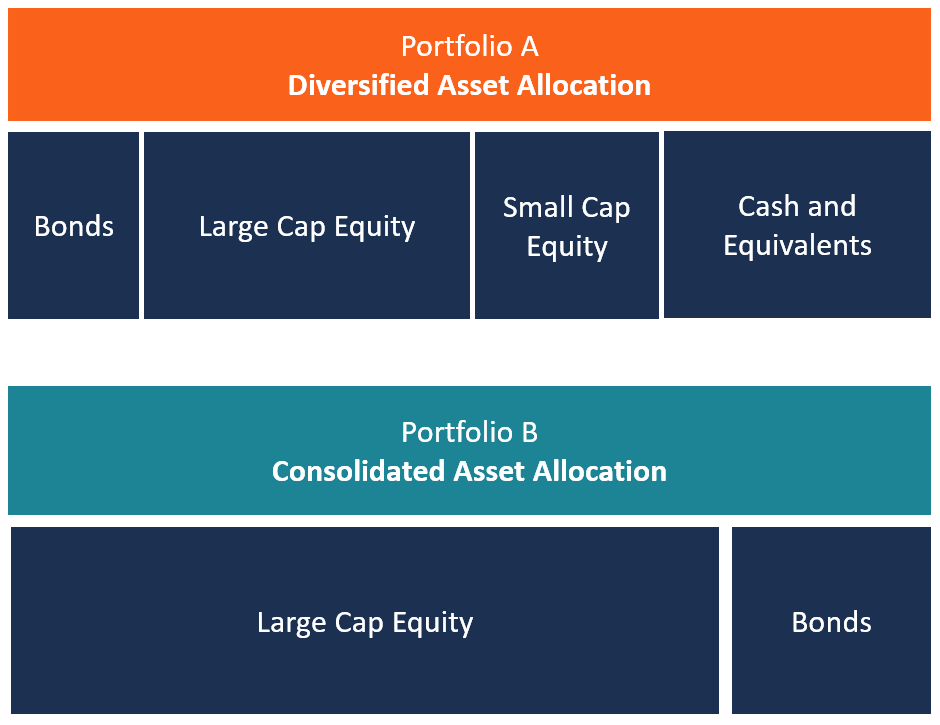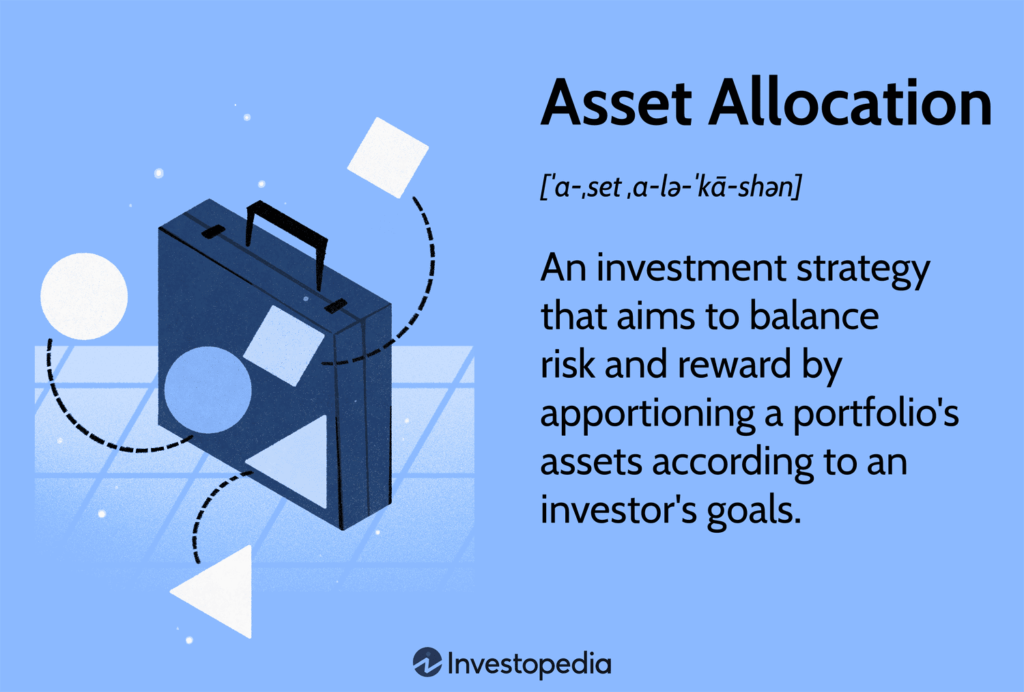Asset allocation plays a crucial role in risk management. It helps diversify investments and reduce potential losses.
Investors use asset allocation to balance risk and reward by spreading investments across various asset classes. This strategy mitigates the impact of market volatility on a portfolio. Diversification ensures that poor performance in one area does not heavily impact the overall portfolio.
Effective asset allocation considers an investor’s risk tolerance, financial goals, and investment horizon. By strategically distributing assets among stocks, bonds, real estate, and other categories, investors can achieve more stable and predictable returns. Understanding and implementing proper asset allocation is vital for long-term financial success and security.

Credit: corporatefinanceinstitute.com
Introduction To Asset Allocation
Asset allocation is a key concept in investing. It helps in spreading investments across different asset classes. This strategy aims to balance risk and reward. By diversifying, investors can potentially reduce their risks. Let’s delve deeper into the role of asset allocation in risk management.
What Is Asset Allocation?
Asset allocation involves dividing investments among various categories. These can include stocks, bonds, and cash. Each category has its own risk and return profile. The goal is to create a diversified portfolio. This helps to manage risk and achieve financial goals.
Importance In Investment Strategy
Proper asset allocation is crucial for any investment strategy. It can affect the overall performance of your portfolio. Here’s why it’s important:
- Risk Management: Diversifying reduces the impact of a poor-performing asset.
- Stability: A mix of assets can stabilize returns over time.
- Goal Alignment: Tailoring allocation can match investment goals and risk tolerance.
A well-balanced portfolio can include various asset classes. Below is a simple table representing a sample asset allocation:
| Asset Class | Percentage |
|---|---|
| Stocks | 60% |
| Bonds | 30% |
| Cash | 10% |
Choosing the right mix depends on various factors. These include age, risk tolerance, and investment horizon. By adjusting the allocation, investors can better manage their risk. It also helps to maximize potential returns.
Types Of Asset Classes
Understanding the different types of asset classes is crucial for effective risk management. Each asset class has unique characteristics and risk profiles. Diversifying your investments across various asset classes can help mitigate risks. Below are some of the main types of asset classes:
Equities
Equities represent ownership in a company. When you buy a stock, you own a part of the company. Equities have high growth potential but also come with higher risks. They are often more volatile than other asset classes. Investing in a variety of stocks can help spread risk. Equities are best suited for long-term investment goals.
Bonds
Bonds are essentially loans that you give to companies or governments. In return, you receive periodic interest payments and the return of the principal amount at maturity. Bonds are generally considered safer than equities. They provide stable income and are less volatile. Investing in a mix of government and corporate bonds can offer a good balance of risk and return.
Real Estate
Real estate involves investing in physical properties like houses, apartments, or commercial buildings. Real estate can provide steady rental income and potential for property value appreciation. It also serves as a hedge against inflation. Diversifying your real estate investments across different locations and property types can reduce risks.
Commodities
Commodities include natural resources like gold, silver, oil, and agricultural products. These assets can be volatile but offer a hedge against inflation. Commodities tend to perform well in different economic cycles compared to stocks and bonds. Investing in a variety of commodities can help balance your portfolio.
| Asset Class | Characteristics | Risk Level |
|---|---|---|
| Equities | High growth potential, volatile | High |
| Bonds | Stable income, less volatile | Medium |
| Real Estate | Steady income, inflation hedge | Medium |
| Commodities | Inflation hedge, volatile | High |
Diversifying across these asset classes can help you achieve a balanced portfolio. Each asset class has its own advantages and risks. Understanding these can help you make informed investment decisions.

Risk And Return Dynamics
Understanding the risk and return dynamics is crucial in asset allocation. It helps in balancing investments to ensure maximum returns with minimal risks. This balance is necessary for long-term financial goals.
Balancing Risk And Reward
Balancing risk and reward involves spreading investments across different asset classes. This helps in managing the overall risk of the portfolio. The main asset classes include stocks, bonds, and cash.
Here’s a simple table showing the risk and return characteristics of these asset classes:
| Asset Class | Risk Level | Expected Return |
|---|---|---|
| Stocks | High | High |
| Bonds | Medium | Medium |
| Cash | Low | Low |
Impact Of Market Volatility
Market volatility impacts the value of investments. During volatile periods, asset prices can fluctuate dramatically. This can cause stress for investors.
Diversifying investments can help mitigate the impact of market volatility. Here are some key points:
- Stocks may drop in value during market downturns.
- Bonds tend to be more stable than stocks.
- Cash provides safety but offers lower returns.
By spreading investments, you reduce the impact of any single asset’s poor performance.

Credit: fastercapital.com
Strategic Asset Allocation
Strategic Asset Allocation plays a pivotal role in risk management. It involves setting a base policy mix of assets, tailored to achieve long-term investment goals. This approach ensures a balanced portfolio that aligns with an investor’s risk tolerance and financial objectives.
Long-term Goals
Strategic asset allocation is centered around achieving long-term goals. These goals can include retirement savings, education funds, or wealth accumulation. The allocation strategy should reflect the investor’s time horizon and risk appetite.
For instance, a young investor might have a higher percentage of equities, aiming for growth. Conversely, an older investor nearing retirement might lean towards bonds, prioritizing capital preservation.
| Investor Type | Equities (%) | Bonds (%) | Other Assets (%) |
|---|---|---|---|
| Young Investor | 70% | 20% | 10% |
| Middle-aged Investor | 50% | 30% | 20% |
| Older Investor | 30% | 50% | 20% |
Rebalancing Portfolios
Regularly rebalancing portfolios is crucial in strategic asset allocation. It involves adjusting the portfolio to maintain the desired asset mix. This ensures the portfolio stays aligned with the investor’s risk tolerance and goals.
For example, if equities outperform, their proportion in the portfolio increases. Rebalancing involves selling some equities and buying bonds or other assets to restore balance.
- Review portfolio quarterly or annually.
- Sell high-performing assets.
- Buy underperforming assets to restore balance.
Rebalancing helps manage risk and ensures the portfolio remains diversified. It prevents over-exposure to any single asset class.
Tactical Asset Allocation
Tactical Asset Allocation (TAA) is a dynamic investment strategy. It involves making short-term adjustments to a portfolio. These adjustments aim to take advantage of market opportunities. TAA can enhance returns and manage risks effectively.
Short-term Adjustments
TAA involves making short-term adjustments to asset allocation. This strategy helps capitalize on market movements. Investors adjust their holdings based on market conditions.
For example, they might increase exposure to stocks during a bull market. Alternatively, they could shift to bonds in a bear market. This flexibility allows for better risk management.
Short-term adjustments can also involve reallocating between asset classes. Investors may move from domestic to international assets. They could also switch between different sectors.
- Increase stock exposure in a bull market
- Shift to bonds in a bear market
- Reallocate between domestic and international assets
- Switch between different sectors
Market Timing
Market timing is a crucial aspect of TAA. It involves making decisions based on market conditions. Investors aim to buy low and sell high.
Effective market timing requires understanding market trends. Investors use technical analysis and economic indicators. They look at historical data to predict future movements.
Market timing can be risky but also rewarding. Successful timing can lead to higher returns. But, poor timing can result in losses.
- Understand market trends
- Use technical analysis
- Analyze economic indicators
- Review historical data
Tactical Asset Allocation requires knowledge and skill. It is not for every investor. But, it can be a powerful tool for those who master it.

Credit: fastercapital.com
Diversification Benefits
Asset allocation is crucial for managing investment risks. Diversification spreads investments across different assets. This approach reduces the impact of any single asset’s poor performance. The benefits of diversification are significant for risk management.
Spreading Risk
Diversification helps in spreading risk. By investing in various asset classes, you reduce dependence on any single investment. For example, if you only invest in stocks, a market crash could hurt your portfolio. But, if you also invest in bonds and real estate, losses in one area might be offset by gains in another.
| Asset Class | Risk Level | Potential Return |
|---|---|---|
| Stocks | High | High |
| Bonds | Low | Medium |
| Real Estate | Medium | High |
Reducing Volatility
Diversification also helps in reducing volatility. Different assets react differently to market conditions. While stocks might be volatile, bonds tend to be stable. By holding a mix of assets, you can smooth out the ups and downs.
- Stocks can be very volatile.
- Bonds usually offer stable returns.
- Real estate provides a hedge against inflation.
This balanced approach makes your investment journey smoother. A diversified portfolio is less likely to experience extreme swings.
Factors Influencing Allocation Decisions
Effective asset allocation is crucial for managing investment risks. Several factors influence these decisions, shaping the portfolio’s balance of assets. Understanding these factors helps in creating a robust investment strategy. Below, we explore the key factors.
Investor Profile
An investor’s profile significantly impacts asset allocation. Key elements include:
- Age: Younger investors may take more risks. Older investors often seek stability.
- Risk Tolerance: This defines how much risk an investor can handle.
- Investment Goals: Short-term and long-term goals vary. These goals shape asset choices.
- Financial Situation: Wealthier investors might diversify more. Limited funds may focus on fewer assets.
Economic Conditions
Economic conditions also guide allocation decisions. Key factors include:
| Factor | Impact |
|---|---|
| Interest Rates | High rates may favor bonds. Low rates might boost stocks. |
| Inflation | Inflation can erode returns. Real assets may hedge against it. |
| Economic Growth | Strong growth often boosts equities. Slow growth may benefit bonds. |
| Market Volatility | High volatility may lead to safer assets. Low volatility might allow riskier investments. |
Both investor profiles and economic conditions are crucial in asset allocation. Balancing these factors can optimize returns and manage risks effectively.
Common Allocation Models
Asset allocation is vital in managing investment risks. Different investors use varied asset allocation models to achieve their financial goals. Let’s explore the common allocation models.
Conservative Model
The Conservative Model focuses on minimizing risk. It prioritizes capital preservation over growth. This model suits investors with low risk tolerance.
- High allocation to bonds and fixed income securities.
- Low allocation to stocks and equities.
- Stable returns with lower volatility.
| Asset Type | Allocation Percentage |
|---|---|
| Bonds | 60% |
| Stocks | 20% |
| Cash | 20% |
Aggressive Model
The Aggressive Model aims for high growth. It involves higher risk. This model is for investors willing to accept short-term volatility for long-term gains.
- High allocation to stocks and equities.
- Low allocation to bonds and fixed income securities.
- Potential for high returns with greater risk.
| Asset Type | Allocation Percentage |
|---|---|
| Stocks | 80% |
| Bonds | 10% |
| Cash | 10% |
Tools And Resources
Asset allocation is essential in risk management. Understanding the tools and resources available can help make informed decisions. This section explores key tools and resources for effective asset allocation.
Software And Platforms
There are many software and platforms that assist with asset allocation. These tools offer advanced analytics and insights. They help in creating diversified portfolios. Here are some popular ones:
- Morningstar Direct: This platform provides comprehensive financial data.
- BlackRock Aladdin: A tool for risk management and portfolio construction.
- Personal Capital: Useful for individual investors managing their portfolios.
These tools offer features like:
- Real-time data analysis
- Risk assessment
- Performance tracking
Using these platforms can help you make smarter investment choices.
Financial Advisors
Financial advisors play a crucial role in asset allocation. They provide personalized advice based on your risk tolerance. Here are some benefits of consulting a financial advisor:
- Expert knowledge of market trends
- Customized investment strategies
- Ongoing portfolio management
Financial advisors can help you achieve your financial goals. They offer valuable insights and strategies. Consulting a professional ensures you are on the right path.
Here’s a comparison table for better understanding:
| Tool/Resource | Features | Benefits |
|---|---|---|
| Software and Platforms | Real-time data, risk assessment, performance tracking | Smarter investment choices, comprehensive analysis |
| Financial Advisors | Expert advice, customized strategies, ongoing management | Achieve financial goals, valuable insights |
Utilizing these tools and resources can significantly enhance your asset allocation strategy. They provide the necessary support for effective risk management.
Conclusion And Future Outlook
Asset allocation plays a vital role in risk management. It helps investors balance their portfolios. A well-balanced portfolio reduces risk and maximizes returns. This section will cover the key takeaways and emerging trends in asset allocation.
Key Takeaways
- Asset allocation is crucial for risk management.
- A diversified portfolio can balance risk and returns.
- Review and adjust your asset allocation regularly.
- Understand your risk tolerance before investing.
- Use a mix of stocks, bonds, and other assets.
Emerging Trends
New trends are shaping the future of asset allocation. These trends provide fresh opportunities and challenges. Staying updated is essential for smart investing.
| Trend | Description |
|---|---|
| ESG Investing | Focuses on Environmental, Social, and Governance factors. |
| AI and Machine Learning | Enhances data analysis for better asset allocation. |
| Cryptocurrencies | Offers new avenues for diversification. |
| Robo-Advisors | Automates investment strategies. |
Investors should consider these trends. They can influence future asset allocation strategies. Adapting to changes ensures better risk management and potential returns.
Frequently Asked Questions
How Does Asset Allocation Help Manage Risk?
Asset allocation spreads investments across different asset classes. This diversification reduces risk by balancing potential losses with gains. It helps maintain portfolio stability and optimize returns.
What Is The Role Of Asset Allocation?
Asset allocation distributes investments across various asset classes. It aims to balance risk and reward according to individual goals. This strategy helps in diversifying the portfolio, reducing volatility, and enhancing potential returns. Proper asset allocation is crucial for long-term financial success.
What Is Asset Management In Risk Management?
Asset management in risk management involves identifying, monitoring, and optimizing assets to minimize risks. It ensures asset efficiency and security.
What Is Risk-based Asset Allocation?
Risk-based asset allocation prioritizes investments based on risk levels rather than potential returns. This approach aims to balance and diversify risk across a portfolio.
Conclusion
Asset allocation plays a vital role in managing investment risk. Diversifying assets helps balance potential returns and risks. A well-thought-out strategy can safeguard your portfolio against market fluctuations. Understanding and implementing asset allocation is key to long-term financial success. Make informed decisions to optimize your investment outcomes and manage risks effectively.

Olga L. Weaver is a distinguished figure in both the realms of real estate and business, embodying a unique blend of expertise in these interconnected domains. With a comprehensive background in real estate development and a strategic understanding of business operations, Olga L. Weaver has positioned herself as a trusted advisor in the complex intersection of property and commerce. Her career is marked by successful ventures in real estate, coupled with a keen ability to integrate sound business principles into property investments. Whether navigating the intricacies of commercial transactions, optimizing property portfolios, or providing strategic insights into market trends, Olga L. Weaver’s expertise encompasses a wide spectrum of both real estate and business-related topics. As a dual expert in real estate and business, she stands as a guiding force, empowering individuals and organizations with the knowledge and strategies needed to thrive in these intertwined landscapes. Olga L. Weaver’s contributions continue to shape the dialogue around the synergy between real estate and business, making her a respected authority in both fields.


